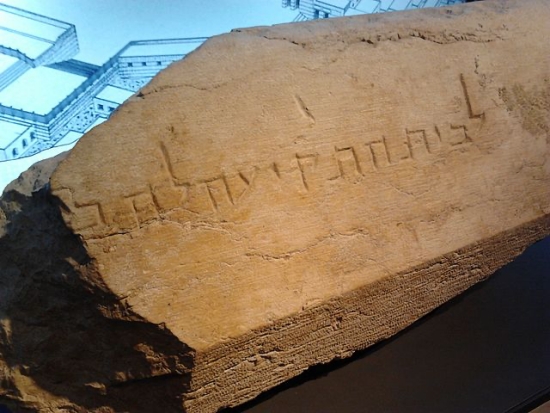Ben & Jerry’s Hypocrisy On Indigenous Rights

The Trumpeting Place inscription from the Second Temple period. Photo: Lunarcalendar, CC 3.0
7/14/2023, 9:04:58 AM
On July 4, 2023, the board of the ice cream giant Ben & Jerry’s made headlines by declaring, “The U.S. Was Founded on Stolen Indigenous Land. This July 4th, Let’s Commit to Returning It.”
The board called for Mount Rushmore to be given to the Lakota tribe, even though the tribe is not indigenous to the Mount Rushmore area.
Ironically, Ben & Jerry’s omitted to mention that its company headquarters in South Burlington, Vermont is located on what appears to be land stolen from the Abenaki tribe. Presumably, the company won’t be “returning it.”
Ben & Jerry’s is no stranger to controversies over indigeneity. Notoriously, it promoted the antisemitic BDS movement, which denies the indigeneity of Israeli Jews.
This was no coincidence. The head of the company’s board is Anuradha Mittal. Bloomberg News visited her office and reported that it is adorned with a “Free Palestine” placard and a poster of two Palestinian men embracing next to a barbed wire fence. The poster says, “Support the Intifada” in Arabic.
“Free Palestine” is a euphemism for destroying Israel and its Jewish population and “Support the Intifada” means support for terrorism.
On July 19, 2021, presumably at Mittal’s direction, Ben & Jerry’s issued a statement that read, “We believe it is inconsistent with our values for Ben & Jerry’s ice cream to be sold in the Occupied Palestinian Territory.”
In 2018, on Israel’s Independence Day, Mittal tweeted, “The catastrophe continues #Nakba70 years later #palestine bleeds Boycott Divest Sanctions #israel.”
Under Mittal, Ben & Jerry’s attitude towards Jewish indigeneity is inconsistent with its alleged support for indigenous rights. It is pure hypocrisy as well as antisemitic.
The Jewish people are clearly the indigenous population of the Land of Israel, including Judea and Samaria. Jews have lived there for over 3,000 years. Muslim Arabs conquered and colonized the land in the 7th century. Even the Muslim Waqf, in its 1925 “A Brief Guide to Al-Haram Al-Sharif,” admitted that Caliph Omar occupied Jerusalem in 637 C.E. and the presence of Solomon’s Temple on the Temple Mount is undeniable.
The Bible is the oldest written record of title. It states in no uncertain terms that title to the Land of Israel is vested in the Jewish people and clearly demarcates its borders. This title was reconfirmed to Moses and the Jewish people. In Moses’s penultimate testament, he calls upon the heavens and the earth to bear witness to the Land of Israel as the inheritance of the Jewish people. This was to the exclusion of any other descendants of Abraham and Isaac.
There is no other comparable legal title to the Land of Israel.
In terms of international law, the Supreme Council of Allied Powers met in San Remo, Italy in 1920 to resolve international claims to self-determination, including on territories controlled by the Central Powers defeated in World War I. These included “Palestine,” which had been under Ottoman rule.
The Supreme Council addressed the Jewish people’s right to the Land of Israel and the reconstitution of their national home there.
The minutes of the Council’s meeting on the matter of “Palestine” are illuminating. They show that representatives of the United States, the British empire, France, Italy and Japan heard presentations from Jewish and Arab representatives.
The Council considered the claims of the various parties, deliberated and decided that “title” to Palestine was vested in the Jewish people. In 1922, the new League of Nations unanimously adopted the San Remo Resolution on Palestine. It explicitly recognized “the historical connection of the Jewish people with Palestine and to the grounds for reconstituting their national home in that country.” The adoption made the resolution an international agreement, binding on all of the member countries.
The resolution contains a number of important legal concepts: It recognized the Jews as the indigenous people of “Palestine.” This recognition was given as the “grounds for” reconstituting the Jews’ national home.
This means that the Jews’ indigenous rights were preexistent to the recognition. Consistent with that principle, the resolution called for “reconstituting”—not “constituting”—the Jews’ national home.
The use of the term “country” is also important. It does not describe a territory of a former empire, but rather an independent state. Thus, the sovereignty and legal title to the country of “Palestine” was vested in the Jewish people from the Jordan River to the Mediterranean Sea.
The resolution included a nationality law to be enacted by the authority that would be given a mandate to temporarily rule “Palestine.” This law was to facilitate Jews’ acquisition of “Palestinian” citizenship. No such provision was made for anyone else.
Moreover, article five of the resolution states, “No Palestine territory shall be ceded or leased to, or in any way placed under the control of the Government of any foreign Power.” This means that the Jewish title to the country of “Palestine” could not be revoked or granted to another people. This provision is also binding on the United Nations as the successor to the League of Nations.
The resolution was endorsed in the 1924 Anglo-American Treaty on Palestine. The Senate approved the treaty, making it the law of the land in the U.S. The treaty incorporated the text of the Council’s resolution. The area delineated for the reconstituted Jewish state was from the Jordan River to the Mediterranean Sea. Thus, under international and U.S. law, Jews have the legal right to live in Judea and Samaria.
Clearly, as a matter of fact and law, title to the Land of Israel is vested in the Jewish people, who are the indigenous people of the land. If Ben & Jerry’s board genuinely support the rights of indigenous people, then they must support the Jewish people’s right to the Land of Israel.